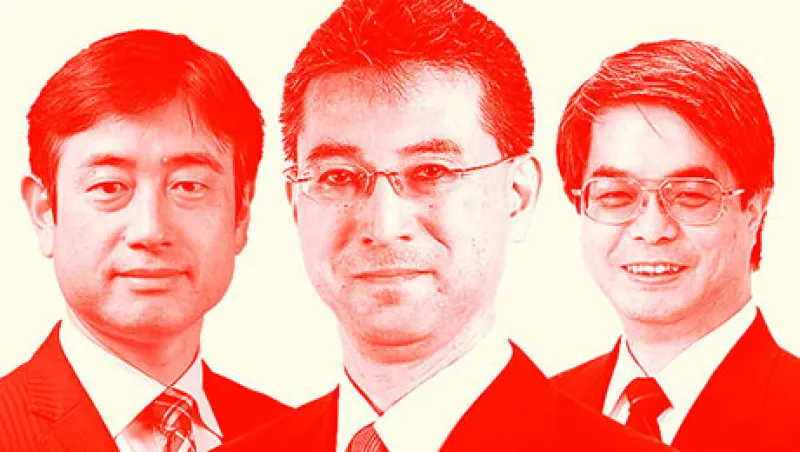Economic data coming out of Japan continues to disappoint. Last month the government estimated that the annualized rate of real gross domestic product growth from October through December was a paltry 1.5 percent, well below consensus expectations of 2.2 percent. Industrial production plunged by 3.4 percent from January to February, the same month in which the nation’s consumer price index failed to advance for the first time in nearly two years.
In mid-March the Bank of Japan acknowledged that inflation is likely to remain flat “for the time being,” prompting many market observers to wonder if policymakers might pursue an even more aggressive program of quantitative easing to jump-start growth in the world’s third-largest economy.
Yohei Osade, Mizuho Securities Group’s global head of pan-Asian equity research, doesn’t believe that will happen, at least in the near term. “In the BoJ’s parlance, ‘for the time being’ generally means around six months,” he says. “The BoJ maintains its assessment that inflation expectations are rising on the whole from a somewhat longer-term perspective. We think about the only cases that would prompt additional easing in the April–June quarter would be core CPI growth well below zero or a broad-based decline in inflation rate expectations.”
| Related Content2015 All-Japan Research Team Hall of FameApril 4, 20152015 All-Japan Sales TeamApril 7, 2015Japan's Top Corporate Access Providers 2015April 8, 2015 |
This anemic backdrop is not inhibiting demand for Japanese equities. In mid-March the benchmark Nikkei 225 index closed above the 19,000 mark for the first time since the spring of 2000 — and within two weeks had advanced an additional 500 points. Understandably, investors want to know how high stock prices will go and when the sustainable recovery promised under Prime Minister Shinzo Abe’s three-pronged program, commonly referred to as Abenomics, will begin. To find out, many portfolio managers will look to the sell side for guidance. The firm whose analysts provide the most helpful insights, they say, is Mizuho Securities, which captures first place on Institutional Investor’s All-Japan Research Team for a second consecutive year. It wins 28 positions, four more than in 2014. Nomura, which shared the winner’s circle with Mizuho last year, slips to second place, with a total of 23.
SMBC Nikko Securities holds steady in third place with 19 spots. Daiwa Securities Group climbs one level to No. 4, after picking up four positions, bringing its total to 18. Two firms share the fifth tier, with 11 spots each. Bank of America Merrill Lynch, whose total falls by five, slips from fourth place, while Mitsubishi UFJ Morgan Stanley Securities Co. jumps from No. 8 even though its total is unchanged from last year.
These results reflect the opinions of more than 1,100 buy-side analysts and money managers at some 375 institutions that collectively oversee an estimated $1.2 trillion in Japanese equities.
Click on Leaders in the navigation table at right to see the full list of ranked firms, or Best Analysts of the Year to view profiles of the people in first, second and third places and to find information about when the researchers debuted in their sectors, the total number of appearances they have amassed to date, their total appearances at No. 1 (where applicable) and comments from money managers about what distinguishes each analyst from his or her peers.
Also available at that link is a list of analysts who earn a runner-up spot in each sector. Please note: Information about individuals in the second and third positions, and runners-up, is available to subscribers only.
The All-Japan Research Team Hall of Fame, which was introduced in 2013, on the 20th anniversary of the survey, to pay tribute to analysts who have earned at least ten sector-topping appearances, welcomes two new members this year: Shinsuke Iwasa of Mizuho Securities Group, who leads the lineup in Broadcasting; and UBS’s Mariko Watanabe, the No. 1 analyst in OTC & Small Companies.
Another Hall of Famer, Nobuyuki Saji of Mitsubishi UFJ Morgan Stanley, extends his winning streak in Economics to a 14th year. He believes the central bank will be compelled to expand its quantitative easing program later this year, most likely in October. Economic growth “still lacks genuine momentum,” he notes, and “government-induced wage hikes are the main factor propping up private sector demand.” Saji forecasts GDP expansion of just 1 percent in the current fiscal year, which began this month.
Nomura’s Konomi expects the nation to grow at twice that rate; while Mizuho’s Osade is the most optimistic of the group, calling for a 2.3 percent increase.
“We maintain our central portfolio focus on domestic demand, due to the downside risk facing the U.S. economy and the upside potential for Japan market demand,” he says.
Retailing is one sector that his team thinks will outpace the broad market in the year ahead. “Nationwide department store sales rose 1.1 percent year-over-year in February, the first increase since last April’s consumption tax hike,” Osade reports. “However, supermarket sales fell 0.8 percent, the 11th consecutive month of decline. The difference results from the department stores’ success in capturing demand from overseas visitors, particularly from China during the Lunar New Year holiday.”
Real wages (total earnings minus year-over-year change in the CPI), which have fallen or flatlined every month for nearly two years, “should turn positive in April once the impact of the consumption tax hike drops out. Large employers have agreed to 2.4 percent wage increases this year, the largest since 1998,” he adds. “Individual stock selection is particularly important in the retail sector, although we remain overweight because consumer spending is set to recover.”
The Mizuho team is also bullish on construction names, which underperformed throughout much of the past 12 months but began to rally in March. “The main objectives of the amended quality assurance act, which took effect in April, are to clarify responsibilities for entities issuing public works orders, prevent underbidding, ensure that contractors can operate at reasonable profit levels and make the industry a more attractive employment option for young people,” Osade explains. “Other laws that come into force in July will enhance site safety. We expect the market to price in a margin recovery at the major construction firms. The industry has not traditionally been known for its focus on shareholders, but we expect a growing number of firms to include [return-on-equity] targets when publishing medium-term plans.”
Konomi shares a positive view of retailers and includes real estate on his list of sectors poised to outperform. “Major rallies in real estate stocks in the past have seen sector share prices rise about five times from their bottom over five to six years,” the Nomura research director explains. “Assuming we have entered a period of prolonged share price gains thanks to the BoJ’s quantitative and qualitative easing, we can expect real estate stocks generally to perform well in cycles of around one year. We still see steady improvement in real estate sector fundamentals.”
One industry that investors would do well to avoid, he adds, is pharmaceuticals. “The government is increasingly attempting to rein in drug expenditures,” Konomi says. “Earnings at makers of branded drugs have been lackluster of late due to government initiatives to encourage greater use of generics. The government is also thinking about constraining drug expenditures over the medium term by introducing cost-benefit analysis and strengthening the role of insurers, with detailed discussions likely from the second half of this year ahead of April 2016 drug price revisions.”
Investors are likely to react negatively to those discussions, he adds, noting that Japan’s pharma shares have generally performed poorly versus the Topix in the year before biannual revisions to National Health Insurance reimbursement prices. “We therefore expect a lackluster performance in 2015,” he summarizes. “Also, decreased interest in dividend yield and the possibility of interest rate rises are other reasons we think the pharmaceuticals sector will underperform.”
Overall, though, he believes that stock prices will continue to move generally upward and has a year-end target of 20,000 for the Nikkei 225. “Improving fundamentals and upgrading corporate governance — which is one big achievement of Abenomics — are basic reasons for the current bull market,” Konomi says. “Looking over the medium term, we forecast that the Nikkei average will reach 25,000 in 2018 under our Abenomics success scenario.”
Osade believes the index will peak this year in June, at 21,000, and then retreat. “Forecasting the level at the end of 2015 is a bit difficult for us because we expect the Nikkei average to move in a range of 18,000–20,000 during the second half of the fiscal year,” the Mizuho research director says, citing a number of factors that could increase volatility — interest rate hikes in the U.S.; supply overhang caused by the initial public offerings of Japan Post Holdings Co., which many analysts expect will set a global record; and “waning public support for the Abe administration as it tries to push through its national security legislation.”
Even so, he sees cause for optimism. Companies are likely to be conservative when issuing their guidance for the current fiscal year, followed by “upward revisions as first-half reporting season approaches,” Osade says. “We have little hope of major positives from the third iteration of the government’s growth strategy [to be published in June], although we do expect stocks to be lifted as the corporate governance code takes effect and companies enhance their distributions ahead of shareholders’ meetings. Also, investors may take a more positive view of the domestic demand recovery from April, when lower year-earlier figures will make retail sales growth look better.”






